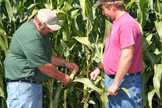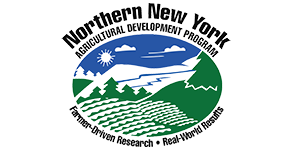 Northern N.Y.; May 14, 2019. The latest data from field research trials evaluating the opportunity to grow high-quality, high-yield corn under localized growing conditions are posted on the Northern New York Agricultural Development Program website at www.nnyagdev.org.
Northern N.Y.; May 14, 2019. The latest data from field research trials evaluating the opportunity to grow high-quality, high-yield corn under localized growing conditions are posted on the Northern New York Agricultural Development Program website at www.nnyagdev.org.
About 65 percent of the approximately 144,000 acres of corn grown each year across the six northernmost counties of New York State is harvested as silage with 35 percent harvested as grain, largely to feed the dairy industry. Ethanol production also contributes to the demand for the regionally-grown corn.
“The importance of corn silage as a high yielding, high quality feed for dairy cattle continues to increase as farmers look to optimize feed value from their available acreage,” said project co-leader Thomas R. Overton, a professor of Animal Science and director of the Cornell University CALS PRO-DAIRY Program, Ithaca, N.Y.
The 2018 trials’ data analysis includes standard measures of performance, including yield, moisture level, and standability as well as innovative techniques for forage quality evaluation for digestibility and milk production. The forage quality data for the 2018 report were collected and analyzed by the field and laboratory research team that included Cornell University faculty, field technicians, and Extension staff working in cooperation with three farm sites in Northern New York.
“As the seed industry introduces new corn hybrids to the market, field evaluation under regional growing conditions is critical to assist growers in selecting the hybrids best-suited to their farm,” noted project co-leader Joseph Lawrence, Cornell CALS PRO-DAIRY Extension Associate, Lowville, N.Y.
The researchers emphasize the need for growers to make hybrid selections based on how the hybrids have performed over multiple years, multiple locations and soils, and under varying weather conditions, and based on the mix of corn traits that best fit their individual farm business needs.
“Corn grain is a valuable commodity in its own right and a major contributor to any hybrid’s silage quality and yield. Grain evaluation trials are typically the first step in determining a hybrid’s value to a regional market,” said project co-leader Margaret E. Smith, professor of plant breeding and genetics at Cornell University, Ithaca, N.Y.
 Corn hybrid testing results for 2018 and recent past years are posted on the Northern New York Agricultural Development Program website at www.nnyagdev.org. Funding for the Northern New York Agricultural Development Program is supported by the New York State Legislature and administered by the New York State Department of Agriculture and Markets. Participating seed companies submitted hybrids for evaluation, helping to defray a portion of the cost of the hybrid evaluations.
Corn hybrid testing results for 2018 and recent past years are posted on the Northern New York Agricultural Development Program website at www.nnyagdev.org. Funding for the Northern New York Agricultural Development Program is supported by the New York State Legislature and administered by the New York State Department of Agriculture and Markets. Participating seed companies submitted hybrids for evaluation, helping to defray a portion of the cost of the hybrid evaluations.
Click here for the Commercial Corn Hybrid Evaluation for Silage and Grain in Northern New York 2018 results report.